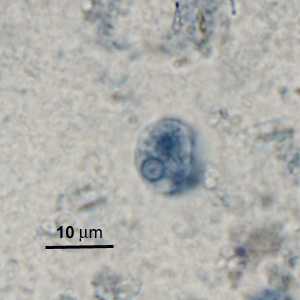
Case #276 - May, 2010

Figure A

Figure B

Figure C

Figure D

Figure E

Figure F
Case Answer
This case presented a mix of three species of protozoa generally considered nonpathogenic: Entamoeba hartmanni (Figures B, C, and E), Endolimax nana (Figures D and F), and Pentatrichomonas hominis (Figure A). Diagnostic morphologic features included:
- a trophozoite of P. hominis containing a single nucleus with a small karyosome and a posteriorly-directed axostyle (Figure A). The trophozoite was also within the size range for P. hominis (6-20 micrometers long).
- a trophozoite of E. hartmanni containing a single nucleus with a small, central karyosome and evenly-distributed peripheral chromatin (Figure B). The trophozoite was also within the size range for E. hartmanni (5-15 micrometers).
- cysts of E. hartmanni containing a nucleus (within the focal plane) with a small, central karyosome and evenly-distributed peripheral chromatin (Figures C and E). The cysts were also in the size range for E. hartmanni (5-10 micrometers in diameter).
- trophozoites of E. nana containing a nucleus with a large karyosome and no peripheral chromatin (Figures D and F). The trophozoites were also within the size range for E. nana (6-12 micrometers).
Although these three species are generally considered nonpathogenic, they should be reported in all routine ova-and-parasite (O&P) examinations. Their presence in stool could indicate fecal contamination of a food or water source and does not rule-out the presence of a true pathogen.
More on: Pentatrichomonas hominis: Endolimax nana and Entamoeba hartmanni
Images presented in the monthly case studies are from specimens submitted for diagnosis or archiving. On rare occasions, clinical histories given may be partly fictitious.
DPDx is an education resource designed for health professionals and laboratory scientists. For an overview including prevention and control visit www.cdc.gov/parasites/.
- Page last reviewed: August 24, 2016
- Page last updated: August 24, 2016
- Content source:
- Global Health – Division of Parasitic Diseases and Malaria
- Notice: Linking to a non-federal site does not constitute an endorsement by HHS, CDC or any of its employees of the sponsors or the information and products presented on the site.
- Maintained By:


 ShareCompartir
ShareCompartir